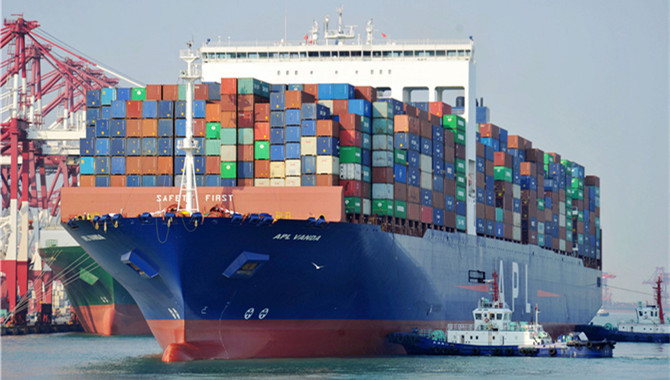Climate experts at a Thursday evening webinar urged China and the US to work together to reduce carbon emissions from ship and airplane traffic.
"So all of the momentum and leadership we've all been seeing and many of us have been a part of cars and trucks for the last couple of decades. We really feel like now is the time to extend that to the seas and the skies," said Madeline Rose, who leads climate campaigns at Pacific Environment.
The regulatory bodies in both China and the US have a strong incentive to end port pollution, she said. Ships and planes have become more and more present in people's daily lives. But with the pandemic-induced supply chain crisis and the port jams that followed, this issue really got pushed to the front burner, Rose said.
"This became much more of a prevalent issue that has really finally risen to a higher public and political awareness," she said.
Rose pointed to the "green" corridor partnership signed in the beginning of the year between the ports of Shanghai and Los Angeles, which aims to create a zero-emissions corridor along one of the world's busiest cargo trade routes by 2030.
The Port of Long Beach has already signed on to the partnership, and many other ports around the Pacific Rim are considering joining the alliance, she said.
"So it's a great first step that does enjoy national support on both sides. And then domestically within China, we see strong potential for inland corridor electrification," Rose said. In the Yangtze River region, for example, there's a lot of potential to increase electrical ships awareness by focusing on inland and short sea corridor electrification projects, she said.
Similarly in the US, there's a lot of political support for the corridor approach, Rose said, adding "there's a lot that can be done there," she said.
The maritime and aviation industries "are huge markets," for the US and China, said Dan Rutherford, program director for the aviation and marine programs at the International Council on Clean Transportation (ICCT), an environmental nonprofit.
The US and China bilateral trade is responsible for approximately 2.5 percent of global shipping carbon dioxide emissions. In addition, flights departing from these two countries accounted for more than a third of carbon emissions in 2019.
The three largest passenger markets for commercial aviation in 2019 were the US, the EU and China. They together accounted for more than half of the total global CO2 emissions from passenger operations, according to the ICCT's research.
"They are going to be huge contributors to the solutions to decarbonize both sectors," Rutherford said.
The International Civil Aviation Organization (ICAO), the UN body that coordinates the principles and techniques of global air navigation, is meeting to hammer out an agreement to reach net-zero airline emissions by 2050.
Sustainable aviation fuel, a replacement for fossil jet fuel, is the key to decarbonization, he said. ICAO is one venue to set common standards and practices on this front. However, ICAO "has pretty weak enforcement powers".
"And so accordingly it has a role of kind of coordinating action and then individual countries then take the lead in implementing and enforcing those policies. So that's another area in which we can see cooperation between China and the US, and that is in implementing the recommended practices that ICAO develops," Rutherford said.
The webinar, titled "opportunities for near-term US-China climate action: tackling the aviation and maritime transportation sectors" was organized by the California-China Climate Institute based in UC Berkeley.
Source: China Daily
The opinions expressed herein are the author's and not necessarily those of The Xinde Marine News.
Please Contact Us at:
media@xindemarine.com


 Ningbo Containerized Freight Index Weekly Commentar
Ningbo Containerized Freight Index Weekly Commentar  Ningbo Containerized Freight Index Weekly Commentar
Ningbo Containerized Freight Index Weekly Commentar  Ningbo Containerized Freight Index Weekly Commentar
Ningbo Containerized Freight Index Weekly Commentar  BIMCO Shipping Number of the Week: Bulker newbuildi
BIMCO Shipping Number of the Week: Bulker newbuildi  Ningbo Containerized Freight Index Weekly Commentar
Ningbo Containerized Freight Index Weekly Commentar  Ningbo Containerized Freight Index Weekly Commentar
Ningbo Containerized Freight Index Weekly Commentar